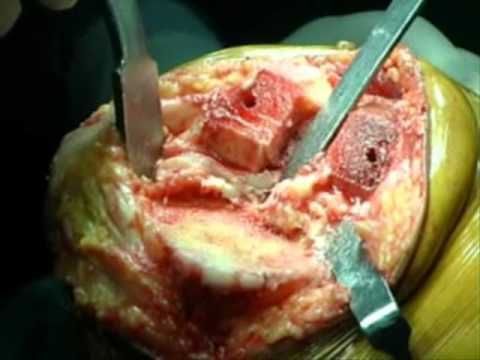Total Hip Replacement
DescriptionThe operation of a total hip replacement is a well established, long lasting procedure for relieving the pain involved with hip arthritis. This type of surgery has been used effectively now for over 40 years and remains the treatment of choice to achieve an excellent quality of life for sufferers of hip arthritis.THE PROCEDUREANAESTHETICThe type of anaesthetic that is used for the procedure will vary according to each patient’s co-existent medical conditions and also your wishes. Our group of anaesthetists are all competent in both general and regional (spinal) anaesthetics and will discuss with you prior to the procedure the benefits and risks of each technique.SURGERYThrough an incision approximately 12-15cm long centred over the side of the hip and curving gently towards the buttock, the hip joint can be entered with minimal trauma to the surrounding muscles. The hip is dislocated and the femur bone is cut through its neck to expose both the pelvic and leg sides of the joint. Depending upon the quality of the bone and the age of the patient either a cemented or cementless component is fixed to the pelvis and similarly to the femur. The ball and socket mechanism of the joint is then reconstructed with either a metal on plastic (polyethylene) articulation or ceramic on ceramic articulation. Computer navigation may be used to ensure that the leg length obtained is correct and the orientation of the components is optimal to provide for maximum range of motion of the new hip.Following the surgery you will be able to mobilize fully weight bearing on the hip the day after the procedure. You will be aided by the physiotherapist and nursing staff and taught how to safely use a frame initially and then graduate onto crutches.Your hospital stay will be between 5-7 days and depending upon your home supports and progress.Most people will be able to dispense with their crutches approximately 4-6 weeks following the surgery. During this time period you should sleep flat on your back, not cross your legs and use a seat raise for the toilet. These precautions will be emphasised by the physiotherapist during your hospital stay.All our patients are routinely put on home based physiotherapy post discharge.AFTER DISCHARGEDriving the car is not allowed for 6 weeks following the surgery and car travel as a passenger should be minimised during this period. These restrictions minimise the chance of the hip dislocating whilst the muscles and soft tissues around your hip heal.At 6 weeks following the procedure you will be reviewed by your surgeon. Most patients are then given the all clear to return to recreational walking, swimming, cycling, golf, tennis, bowls, gymnasium workouts and other recreational pursuits as desired. It is not advised that you undertake running or jumping activities following a hip replacement.FREQUENTLY ASKED QUESTIONSWhat are the risks involved with the procedure?There are general risks associated with any surgery, these are those of the anaesthetic (please speak to your anaesthetist prior to the operation), bleeding, blood clots (deep vein thrombosis (DVT) and pulmonary embolization (PE)), infection and vascular injury. Specific to the surgery are the risks of dislocation of the hip prosthesis, leg length inequality, fracture of the pelvis or femur, wear and loosening of the implants, audible ‘squeaking’ of the articulating components (ceramics), nerve injury.When can I return to work?Most people should be able to return to work at 6 weeks post-surgery. This may be extended if you perform a job involving heavy manual labour.When can I resume sexual activity?Sexual intercourse can safely be undertaken 6 weeks following the surgery.How long do I need to keep taking pain-killing medicine for?When you leave the hospital you will be given tablet analgesia for pain. You should take this for as long as you have pain when walking or at night. Most people are able to cease analgesics by 4 weeks following the surgery.Do I need to do physiotherapy when I go home?You will be given a sheet of exercises from the physiotherapist when you leave the hospital. You should do these exercises as instructed. You do not need to visit a physiotherapist once discharged.Hip Replacement surgery is being successfully performed for the last Sixty years Every year thousands of patients benefit from this surgery in India.This operation helps in relieving pain, gaining range of motion and improving walking ability in variety of hip disorders.It converts a disabled person to an able person. Converts a liability to an asset.The schedule given here is guideline, individual variations may occur. The end result may vary in different individuals, and in two operated hips in the same individual.The result depends on various factors like the cause of arthritis, age and general condition of the patient, condition of the joint, affection of other joints of the body. On an average the artificial joint works well up to 10 years in majority of cases with encouraging reports of success beyond 20 years.Every effort will be made to keep lengths of limbs equal.
READ MORE


















